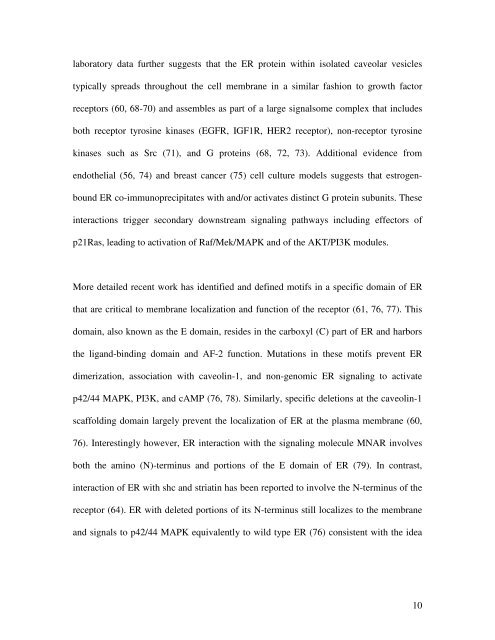You also want an ePaper? Increase the reach of your titles
YUMPU automatically turns print PDFs into web optimized ePapers that Google loves.
laboratory data further suggests that the <strong>ER</strong> protein within isolated caveolar vesicles<br />
typically spreads throughout the cell membrane in a similar fashion to growth factor<br />
receptors (60, 68-70) and assembles as part of a large signalsome complex that includes<br />
both receptor tyrosine kinases (EGFR, IGF1R, H<strong>ER</strong>2 receptor), non-receptor tyrosine<br />
kinases such as Src (71), and G proteins (68, 72, 73). Additional evidence from<br />
endothelial (56, 74) and breast cancer (75) cell culture models suggests that estrogen-<br />
bound <strong>ER</strong> co-immunoprecipitates with and/or activates distinct G protein subunits. These<br />
interactions trigger secondary downstream signaling pathways including effectors of<br />
p21Ras, leading to activation of Raf/Mek/MAPK and of the AKT/PI3K modules.<br />
More detailed recent work has identified and defined motifs in a specific domain of <strong>ER</strong><br />
that are critical to membrane localization and function of the receptor (61, 76, 77). This<br />
domain, also known as the E domain, resides in the carboxyl (C) part of <strong>ER</strong> and harbors<br />
the ligand-binding domain and AF-2 function. Mutations in these motifs prevent <strong>ER</strong><br />
dimerization, association with caveolin-1, and non-genomic <strong>ER</strong> signaling to activate<br />
p42/44 MAPK, PI3K, and cAMP (76, 78). Similarly, specific deletions at the caveolin-1<br />
scaffolding domain largely prevent the localization of <strong>ER</strong> at the plasma membrane (60,<br />
76). Interestingly however, <strong>ER</strong> interaction with the signaling molecule MNAR involves<br />
both the amino (N)-terminus and portions of the E domain of <strong>ER</strong> (79). In contrast,<br />
interaction of <strong>ER</strong> with shc and striatin has been reported to involve the N-terminus of the<br />
receptor (64). <strong>ER</strong> with deleted portions of its N-terminus still localizes to the membrane<br />
and signals to p42/44 MAPK equivalently to wild type <strong>ER</strong> (76) consistent with the idea<br />
10











